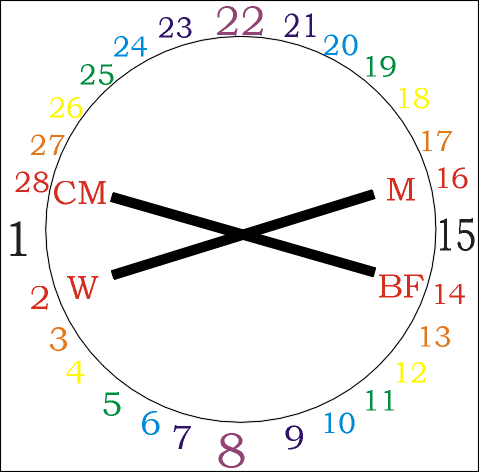
F: Delusion
F: Cunning
2 FCM
28 TM
| The attributes of the Faculties when Will is at Phase 2 | derived from | modified by | from | description | ||
| Will | Beginning of energy | 2 | ||||
| Mask | True | Player on Pan’s Pipes | 16 | BF | 28 | Enforced illusion |
| False | Fury | CM | 14 | Vehemence | ||
| Creative Mind | True | Hope | 28 | BF | 16 | The Fool |
| False | Moroseness | FCM | 2 | Cunning | ||
| Body of Fate | None except monotony | 14 | ||||
| Composite of Faculties | |
|---|---|
| true | Beginning of energy seeks to deliver hope, modified by the Fool, from the player on Pan's pipes, modified by enforced illusion, with the help of monotony. |
| false | Beginning of energy is misdirected into moroseness, modified by cunning, bringing fury, modified by oblivion, separated from monotony. |
 | Attributes of Phase 2 | affects | modifies | |
| Will | Beginning of energy | 2 | - | |
| Mask | T:
Illusion
F: Delusion | 16 | - | |
| Creative Mind | T:
Physical activity
F: Cunning | 28 | 14 TM 2 FCM | |
| Body of Fate | Enforced love of the world | 14 | 16 FCM 28 TM | |
See AV B 105 & 96.
Yeats’s description of the phase from A Vision | ||
|
When the man lives out of phase and desires the Mask, and so permits it to dominate the Creative Mind, he copies the emotional explosion of Phase 16 in so far as difference of phase permits. He gives himself to a violent animal assertion and can only destroy; strike right and left. Incapable of sharing the spiritual absorption of Phase 28, his Creative Mind fills him with ignorance and gloom.
But if he live according to phase, he uses the Body of Fate to clear the intellect of the influence of the Mask. He frees himself from emotion; and the Body of Fate, derived from Phase 14, pushes back the mind into its own supersensual impulse, until it grows obedient to all that recurs; and the Mask, now entirely enforced, is a rhythmical impulse. He gives himself up to Nature as the Fool (Phase 28) gave himself to God. He is neither immoral nor violent but innocent; is as it were the breath stirring on the face of the deep; the smile on the face of a but half-awakened child. Nobody of our age has, it may be, met him, certainly no record of such meeting exists, but, were such meeting possible, he would be remembered as a form of joy, for he would seem more entirely living than all other men, a personification or summing up of all natural life. He would decide on this or that by no balance of the reason but by an infallible joy, and if born amid a rigid mechanical order, he would make for himself a place, as a dog will scratch a hole for itself in loose earth. Here, as at Phase 16, the ordinary condition is sometimes reversed, and instead of ugliness, otherwise characteristic of this as of all primary phases, there is beauty. The new antithetical tincture (the old primary reborn) is violent. A new birth, when the product of an extreme contrast in the past life of the individual, is sometimes so violent that lacking foreign admixture it forestalls its ultimate physical destiny. It forces upon the primary, and upon itself a beautiful form. It has the muscular balance and force of an animal good-humour with all appropriate comeliness as in the Dancing Faun. If this rare accident does not occur, the body is coarse, not deformed, but coarse from lack of sensitiveness, and is most fitted for rough physical labour. Seen by those lyrical poets who draw their Masks from early phases, the man of Phase 2 is transfigured. Weary of an energy that defines and judges, weary of intellectual self-expression, they desire some 'concealment', some transcendent intoxication. The bodily instincts, subjectively perceived, become the cup wreathed with ivy. Perhaps even a Body of Fate from any early phase may suffice to create this Image, but when it affects Phase 13 and Phase 14 the Image will be more sensuous, more like immediate experience. The Image is a myth, a woman, a landscape, or anything whatsoever that is an external expression of the Mask.
(AV B 105-107) |
See a broader view of the Phase in the consideration of the Phase Triads.